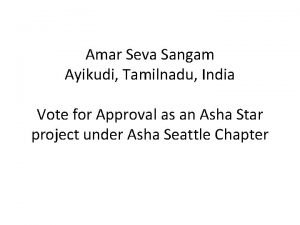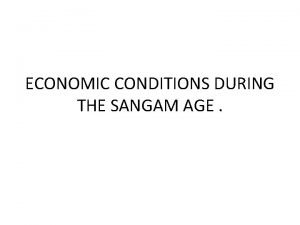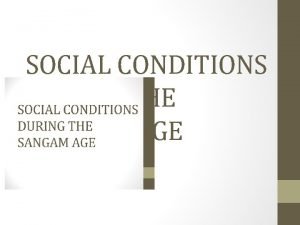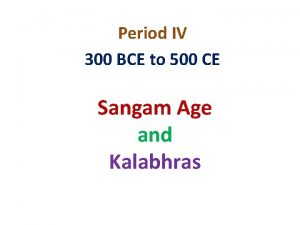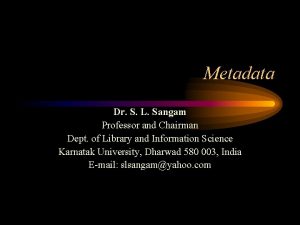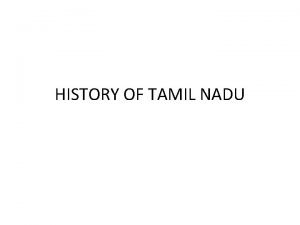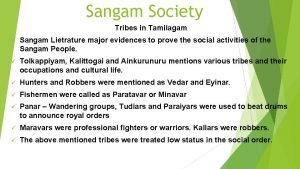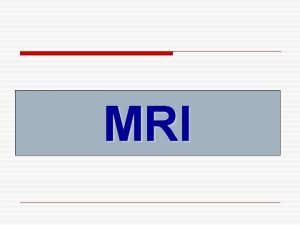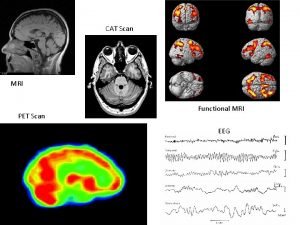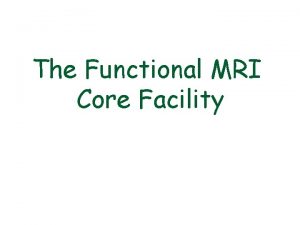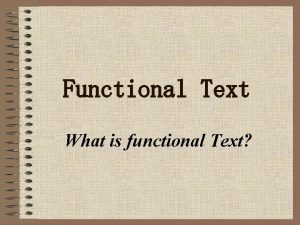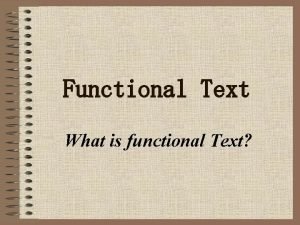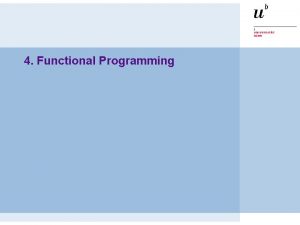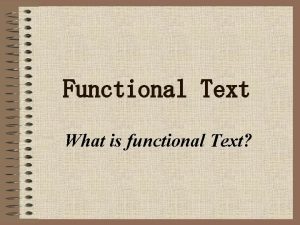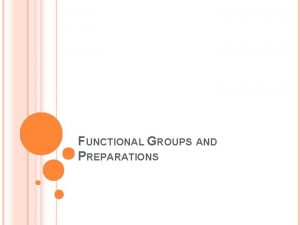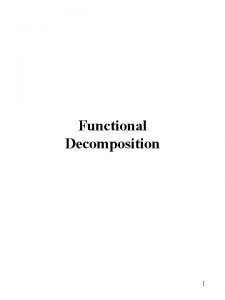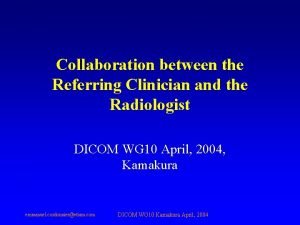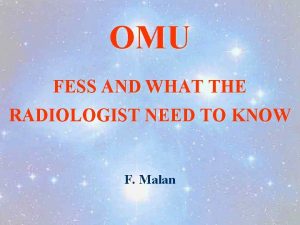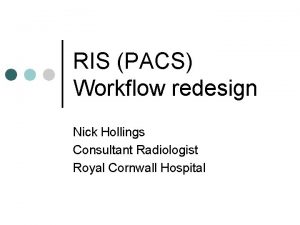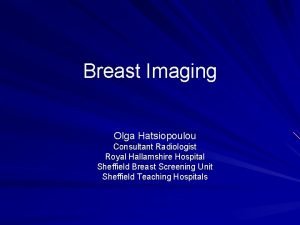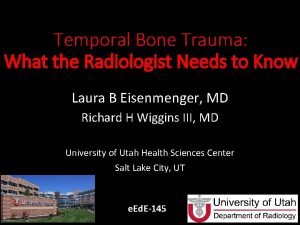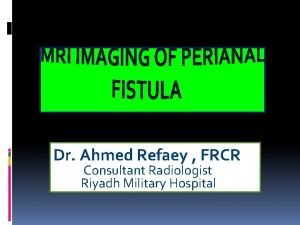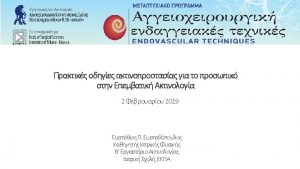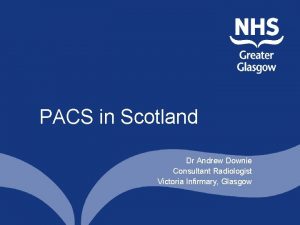Functional MRI f MRI Primer for Radiologist Sangam









































- Slides: 41

Functional MRI (f. MRI) Primer for Radiologist Sangam Kanekar, M. D. Depts. of Radiology and Neurology. Penn State Milton S Hershey Medical Center and College of Medicine

Conflict of Interest Statement Neither I nor my immediate family members have a financial relationship with a commercial organization that may have a direct or indirect interest in the content.

Abstract Purpose: 1. To discuss the principles and physics of BOLD f. MRI technique 2. To illustrate with examples f. MRI application in the clinical practice particularly in the neurodegenerative disease and for presurgical planning. 3. To understand the challenges and limitations of f. MRI. Approach: Functional magnetic resonance imaging (f. MRI) is an advanced imaging technique which helps us to visualize the neuronal activity of the human brain. The f. MRI has been used extensively for investigating various brain functions, including vision, motor, language, and cognition. One of the primary indications for f. MRI is evaluation of eloquent areas of the brain in relation to a focal parenchymal brain lesion such as neoplasm or arterial venous malformation. f. MRI is also used to localize language centers, visual pathways and in analyzing the episodic, semantic and working memory. f. MRI has gained significant importance over a decade due to collateral advances in the noninvasive-/micro-neurosurgical techniques. Increasing indications are also seen in the evaluation of epilepsy and dementia patients, making it even more important for radiologist to understand when indicated to incorporate this high end modality technique in our practice. Findings We classify this exhibit into five parts. Part I explains the various f. MRI techniques, with detail physiology, and principle of BOLD imaging. Part II of the exhibit explains in details the various commonly employed tasks which include: a) Visual, b) Auditory, c) Motor (finger tapping, foot movement, and leg movements) d) Speech language (word generation, verb generation and sentence composition) and e) Memory testing. Part III illustrates in short the normal relevant cortical brain anatomy, Part IV discuss and explain with examples the application of f. MRI in various (neurology and neurosurgery) clinical patients. Part V of the exhibit discusses the challenges and limitations of f. MRI. Summary / Conclusion 1. Functional MRI is a very powerful method to map brain functions with relatively high spatial and temporal resolution. 2. We illustrate with examples the application and limitations of this technique for various neurology and neurosurgical conditions. 3. For participants, this exhibit will be core learning module to understand the principles and basic physics of BOLD f. MRI technique and; how to perform and interpret the f. MRI.

Part I: explains the various f. MRI techniques, with detail physiology, and principle of BOLD imaging. Physiology, and Principle of BOLD Imaging Two main principles 1 basic principle of f. MRI Regional Cerebral Blood Flow Could Reflect Neuronal Activity 1890, experiments of Roy and Sherrington at Cambridge University Synaptic signaling metabolic signaling Vascular response BOLD signal 2 difference in the magnetic properties of oxyhemoglobin and deoxyhemoglobin (d. Hb).

1 Part I ↑ Neuronal Activity ↑ O 2 extraction ↑ Deoxyhemoglobin (T 2* dark signal) Cerebral blood flow Oxyhemoglobin (T 2* bright signal) increase in the ratio of O-Hb to D-Hb. ↑ BOLD Signal Blood Oxygenation Level Dependent (BOLD) signal: As the neuronal activity in the specific region of brain tissue increases with a particular task, there is an increase in the local increase in energy and oxygen consumption in functional brain areas, which is followed by an increase of regional cerebral blood volume (r. CBV) and regional cerebral blood flow (r. CBF). Since increased neuronal activity results in an increase in blood flow beyond the exact demand, more oxygenated hemoglobin appears in the venous capillaries. This shifts the relation between oxygenated and deoxygenated hemoglobin neural activity blood flow oxyhemoglobin T 2* f. MR signal

2 Part I Magnetic susceptibility of Oxy. Hb (diamagnetic) is some what EQUAL to tissue, therefore field is uniform, therefore MRI signal is high. Magnetic susceptibility of de. Oxy. Hb (paramagnetic) is >>> to tissue, therefore field is non-uniform, therefore MRI signal is low. Origins of the BOLD effect in f. MRI. While arterial blood is similar in its magnetic properties to tissue, deoxygenated blood is paramagnetic and so induces inhomogeneities within the magnetic field in tissue. Rest Activation As the oxygenation increases MR (BOLD) signal increases These cause the MRI signal to decay faster. Due to more Oxy. Hb signals from activated regions of cortex increase as the tissue becomes more magnetically uniform.

Part I MRI T 2* Signal Activation 20 seconds Rest 20 seconds Repeat 8 times Rest Activation Rest The most commonly used paradigms are “blocked” designs, in which the subject repeatedly performs a task for a specified time, resting for a similar time between repetitions (i. e. , alternating “task” and “control” blocks). This repetition is required for statistical processing to detect the small signal changes that characterize the BOLD response, on the order of 1 to 5% at 1. 5 tesla (T) or 2 to 10% at 3. 0 T, against a background of physiologic noise. Discussion of detail post-processing technique is beyond scope of this exhibit.

Part II illustrates in short the normal relevant cortical brain anatomy, Part IV discuss and explain with examples the application of f. MRI in various (neurology and neurosurgery) clinical patients. CORTICAL ANATOMY There are four major areas very successfully analyzed by f. MRI: the primary motor cortex, the primary sensory cortex, the premotor cortex, and the supplementary motor area (SMA). The motor and sensory gyri often referred to as one larger area termed the primary sensorimotor cortex THE PRIMARY SENSORIMOTOR CORTEX To identify and differentiate the sensory and motor cortex it is important to identify the central sulcus. Gyrus anterior to the CS is motor while posterior is sensory gyrus. Central sulcus also marks the posterior limit of the frontal lobe and the sensory gyrus marks the start of the parietal lobe. The motor gyrus is somatotopically mapped; different body regions are distinctly represented in cortical space in a common. = postcentral gyrus (sensory) = precentral gyrus (motor) = central sulcus = precentral sulcus = postcentral sulcus

THE CENTRAL SULCUS Part II How to identify central sulcus ? • • • superior frontal sulcus - pre CS sign the posterior end of the superior frontal sulcus joins the precentral sulcus in 85% sigmoidal Hook sign-- Hook like configuration of the posterior surface of the precentral gyrus the “hook” corresponds to the motor hand area. The “hook” is well seen on CT (89%) and MRI (98%). pars bracket sign--The paired pars marginalis form a “bracket” to each side of the interhemispheric fissure at or behind the central sulcus (96%). Superior frontal sulcus Precentral sulcus Ʊ

Part II THE CENTRAL SULCUS How to identify central sulcus ? • Bifid post-CS sign-- the post-CS is bifid (85%). The bifid post-CS encloses the lateral end of the pars marginalis (88%). • Thin postcentral gyrus sign-- the postcentral gyrus is thinner than the precentral gyrus (98%). • Intraparital sulcus-post-CS intersection--in axial MRI/CT, the intraparietal sulcus intersects the post-CS (99%). • Midline sulcus sign--the most prominent convexity sulcus that reaches the midline interhemispheric fissure is the CS (70%). Thin postcentral gyrus sign Postcentral sulcus Midline sulcus sign intraparietal sulcus

Part II Precentral sulcus Precentral gyrus Postcentral gyrus Central sulcus Precuneus Postcentral sulcus Paracentral lobule Supramarginal gyrus Postcentral sulcus It is of vital importance to understand memorize few of the important anatomical land marks of the brain. Without knowing eloquent areas of the brain especially which take part in motor, sensory, memory and visual cortex (sulci, gyri) it will be impossible to understand interpret f. MRI. We illustrate here the most important sulci and gyri, which are very essential for day to day reading of f. MRI. We have discussed these eloquent areas first on the structural imaging and then try to identify them along with various paradigm on f. MRI.

Part II Central sulcus Precentral sulcus Central sulcus Superior parietal gyrus Postcentral sulcus Superior Temporal gyrus Superior Temporal sulcus Middle Temporal gyrus Inferior Temporal gyrus

Part II Paracentral lobule Cingulate gyrus Marginal ramus of Cingulate sulcus Central sulcus Marginal ramus of Cingulate sulcus Precentral gyrus Gyrus rectus Subcallosal gyrus Cingulate sulcus

Part II Superior Frontal gyrus Superior Frontal sulcus Middle Frontal gyrus Postcentral gyrus Paracentral lobule Central Sulcus Precentral sulcus Supramarginal gyrus Cingulate gyrus Heschl’s gyrus Precentral gyrus Parahippocampal gyrus Entorhinal area Amygdala Superior Middle Inferior Temporal gyrus

Part II MOTOR HOMUNCULUS SENSORY HOMUNCULUS

SUPPLEMENTARY MOTOR AREA (SMA) Part II • The SMA is located in the superior frontal gyrus just medial to the superior frontal sulcus. • The SMA can be roughly divided into three parts: anterior, middle and posterior. Anterior portion (pre-SMA), more active on f. MRI during language tasks, and a posterior portion, more active on f. MRI during motor tasks. A centralized region of the SMA that is active during both language and motor tasks. • The motor portion of the SMA is, like the primary motor gyrus, also somatotopically arranged. The SMA is broadly responsible for motor planning and activates temporally before the primary motor gyrus. • The SMA has been shown to be involved in temporal planning and organization of motor movements before execution, in addition to sequencing multiple movements. The SMA is found in the posterior aspect of the superior frontal gyrus in the region of cortex medial to the precentral sulcus. Anterior to the paracentral lobule (foot motor). activation of the SMA during finger tapping:

Part III Motor Pathway Superior Frontal Gyrus Superior Frontal Sulcus Precentral Gyrus Central Sulcus Postcentral Gyrus Centrum Semiovale. Corona Radiata Internal capsule Starts with the upper motor neurons in the primary motor cortex. Axons from these neurons traverse the centrum semi ovale to the corona radiata. The tracts continue through the posterior limb of the internal capsule They then continue caudally via the cerebellar peduncles (midbrain) and basilar pons Finally the fibers enter the medullary pyramids, and then decussate to become the lateral corticospinal tract in the spinal cord.

Part II The Primary Visual Cortex Visual processing areas (V 1, V 2, V 3, V 4, V 5/MT, V 6, intraparietal sulcus regions) each have a complete retinotopic map of visual space, & each is largely dependent on the primary visual cortex for its activation. Extrastriate cortical areas project to temporal & parietal cortical association areas. Parieto-occipital sulcus Upper retinal Q 17 Calcarine fissure Inferior fibers (Meyer's loop) ==below the calcarine fissure superior and central tracts ==above the calcarine fissure 18 18 Lower retinal Q 17 Primary visual cortex

The Primary Visual Cortex Cingulate sulcus Subparietal sulcus Calcarine sulcus Lingual Gyrus Part II

COMMON PARADIGMS Part III f. MRI localization depends on the paradigm used to elicit the activation. Specific motor tasks should be selected based on the location of the lesion. f. MRI may be performed using TWO TYPES OF PARADIGMS BLOCK DESIGNS EVENT-RELATED PARADIGMS stimulus ON and OFF • • • stimuli are presented in alternating short runs (“blocks”) of several seconds’ duration, and the MRI signals are then compared for the two types of blocks. Example of motor task would have the patient resting for 5 images and finger tapping for 5 images. This alternating cycle of rest and task would repeat 5 or 6 times and last approximately 5 minutes Example for visual-stimulation task to localize primary visual areas, a subject might view a bright flickering checkerboard for 20 seconds, followed by a dark screen for 20 seconds, with these blocks repeated several times; eight pairs of blocks • In an event-related design the patient performs one event (eg, a finger tap), which is followed by rest. • It records the event-related potentials (ERPs) in electrophysiological studies. • This type of design requires many repetitions because the change from baseline for any one event is small and therefore takes longer time

Part III COMMON PARADIGMS Number of the paradigms performed varies from institution and clinical question. Since the cooperation of the patient is a must it may not be practical of doing all the paradigms. In case of preoperative planning paradigm may be tailed depending on the location of the lesion. Few of the commonly performed paradigm include: MOTOR • • Bilateral Complex Finger • Tapping Unilateral Sequential Finger • • Tapping Lip Puckering and Tongue • • Movement • Unilateral Foot/Ankle • Movement Passive hand stimulation • • Motor Task • • SPEECH AND LANGUAGE MEMORY VISION Auditory Responsive Naming Task Temporal Phase Semantic Decision Task (Visual) Mapped Visual Field Text reading vs. non-linguistic symbols Visual Field Rhyming Eccentricity Silent Word Generation Polar Angle Simple object naming (Rotating Wedges) Passive Listening The Visual Language Comprehension Task Silent Verb Generation Task Word Listening Task Noun-verb semantic association task • • Novel vs Familiar Face-Name Memory Encoding/Retrieval Task Visual Memory Paradigm The most common MRI sequence used in BOLD f. MRI is a T 2* gradient-echo sequence usingle-shot echo planar imaging(EPI), which allows whole-brain data collection in a few seconds or less. This high speed comes at the expense of spatial resolution, which is substantially lower than for a conventional MRI scan. Another drawback to EPI is distortion and signal loss in the frontotemporal regions secondary to the sensitivity of EPI to magnetic susceptibility differences.

Motor and Premotor Part III Paradigm: Bilateral Complex Finger Tapping Paradigm description: bilateral simultaneous complex finger tapping. Subjects tap fingers bilaterally in the sequential order of 1, 3, 5, 2, and 4. important aspect of he task is the sequencing of the finger movements, rather than location. Activation patterns: robust activation in the bilateral sensorimotor cortex, bilateral SMA, bilateral basal ganglia, bilateral thalami, and bilateral superior cerebellum. Additional areas of activation are oftentimes noted in the bilateral premotor regions. Paradigm: Unilateral Sequential Finger Tapping. For the sequential finger tapping task, the patient is asked to tap their thumb to each finger of their hand in a sequential manner at a self-paced rate on a “go” command to continue tapping until a ”stop” command is presented. RIGHT finger tapping will activate the LEFT precentral gyrus while LEFT finger tapping will activate the RIGHT precentral gyrus.

Right hand tapping Alternating Right and Left hand tapping An alternating finger tapping paradigm demonstrates the contralateral relationship the cerebellar and cerebral hemispheres have in motor control. Activation patterns: robust activation in the bilateral sensorimotor cortex, bilateral SMA, bilateral basal ganglia, bilateral thalami, and bilateral superior cerebellum. Additional areas of activation are oftentimes noted in the bilateral premotor regions.

Unilateral Foot/Ankle Movement Part III Another way in which f. MRI contributes significantly to motor gyrus localization is in the foot motor region. The foot motor region is located most medially just over the interhemispheric fissure. Left foot tapping Paradigm: Patient is asked to dorsiflex and plantar flex the foot and ankle in a smooth, steady manner at a self-paced rate on a “go” command to continue tapping until a ”stop” command is presented. Right foot tapping Activation patterns: Robust activity results in premotor and primary sensori-motor activation (about the superior termination of the central sulcus and in the paracentral lobule) + SMA activation is seen. Secondary somatosensory activation may also be observed. Premotor cortex and cerebellar activation is variable.

Lip Puckering/Tongue Movement Paradigm: For lip-puckering, patients are asked to pucker their lips repeatedly on a visually presented, or auditory, “go” command. Tongue movement task, patients are asked to wiggle their tongue back and forth in a closed mouth Subcentral Lobule Activation patterns: activation about the lateral central sulcus in the expected somatotopic location for lower face sensorimotor cortex. Secondary somatosensory, premotor cortex, and SMA activation are also observed. Tongue movement will activate similar areas, but with primary sensori-motor cortex located along the homunculus Lip movement Part III

LANGUAGE TASK Part III Introduction: Language is a collection of highly skilled interconnected process in which multiple areas of the brain take part for a distinct function. Many linguistic and nonlinguistic tasks require neural systems that process auditory or visual sensory information. For example: Word production begins with retrieval of a concept from a store of semantic knowledge (semantic processing), followed by activation of a sound-based representation of the target word (phonological processing). thus there is considerable overlap in the brain regions activated by production and comprehension tasks. The main goal of f. MRI language mapping for presurgical planning is to: a) cerebral hemispheric language LATERALIZATION (dominance) and b) the spatial PROXIMITY OF ELOQUENT LANGUAGE REGIONS to potentially brain lesions such as brain tumors. THEREFORE The paradigms designed for language mapping should elicit activation in the speech productive areas in the frontal lobe as well as the receptive language areas in the temporal and parietal lobes.

LANGUAGE TASK Part III Depending on the case, site of the lesion or pathology/disorder suspected any of the following paradigm is selected: Paradigm used to study language function • • • Auditory Responsive Naming Task Semantic Decision Task (Visual) Text reading vs. non-linguistic symbols Rhyming Silent Word Generation Simple object naming Passive Listening The Visual Language Comprehension Task Silent Verb Generation Task Word Listening Task Noun-verb semantic association task

LANGUAGE TASK The choice of the paradigms that are administered depends mainly on the location of the lesion and the patient’s neurological deficits. They are usually categorized into three groups: EXPRESSIVE elicit activation mainly in the speech production areas. **Silent Word Generation, Silent Verb Generation, and Simple Object Naming are among the most used and cited verbal fluency paradigms in f. MRI the dorsolateral prefrontal cortex (DLPFC), inferior frontal gyrus (IFG), variably within cingulate language regions, supplementary motor area (SMA), premotor and motor regions and occasionally the parietal, temporal, and/or occipital cortex depending on whether auditory or visual stimuli are used. RECEPTIVE paradigms is designed to identify mainly receptive language regions in the temporal and parietal lobe, Wernicke’s area (the posterior aspect of the left STG) **Sentence reading or listening comprehension entire language network including Broca’s area (BA, left IFG), Wernicke’s area (WA, posterior left STG) & right hemispheric homologues, DLPFC, ITG, middle temporal gyrus (MTG), angular (AG) and supramarginal gyrus (SMG), other parietal language cortices and SMA SEMANTIC PARADIGMS intended to activate both key expressive and receptive language cortices, including Broca’s and Wernicke’s. **a noun to verb association (e. g. dogbarking), a word category association (e. g. applefruit), and Sentence completion the dominant cerebral hemisphere within the IFG, posterior temporal, and inferior parietal speech areas.

Part III Silent Word Generation Simple object naming Paradigm: This task visually presents letter during the activation state and a nonsense symbol during the control condition. During letter presentation, patients are instructed to think of as many words as possible that begin with the letter presented on the screen. Paradigm: The active tasks consist of presenting simple objects that the subject names silently, at a rate of approximately one object every 3 seconds. The control task utilizes a nonsense symbol for visual fixation and to minimize elementary visual cortical activation Activation patterns: the dorso-lateral prefrontal cortex, inferior frontal gyrus, variably within cingulate language regions, SMA, premotor and motor regions. Posterior language cortex may also activate to this task. Small amounts of activity can be seen in the ventral occipito-temporal cortex. Activation patterns: activity within the inferior frontal gyrus (frontal operculum), dorsal lateral prefrontal cortex, or premotor cortex, SMA, ventral occipito-temporal cortex (VOTC), and to a variable extent within the posterior temporo-parietal language cortex. The task will also variably cause activation of posterior temporal or temporo-parietal opercular cortex, corresponding to language relevant cortex.

The Visual Language Comprehension Task Advantages of this task include robust language lateralization of both frontal and temporal language regions and the ability to measure behavioral data related to task performance. A visual language comprehension task is useful for clinical questions regarding language localization in Broca’s area (inferior frontal lobes) and Wernicke’s area (posterior superior temporal sulci) and hippocampal structures. Eye movement areas (precentral sulci, medial frontal lobes, intraparietal sulci), unilateral thumb movement (finger switch in dominant hand), working memory (middle frontal gyri) and primary and associative visual areas (occipital areas) are also mapped. Part III Silent Verb Generation Task Patient generates verbs related to visually presented written nouns. Delivered via LCD projector and mirror setup as visual stimuli. receptive speech areas in frontal regions

VISION Part III Vision - Temporal Phase Mapped Visual Field Eccentricity (Expanding Rings) and Polar Angle (Rotating Wedges): Neurons responding preferentially to visual stimulation at different locations in the visual field are activated at different times during each of the stimulus sequences. Corresponding differences in the temporal phase of the f. MRI responses thus indicate the eccentricity and polar angle represented by each brain voxel. Used to efficiently map visually responsive brain areas that are retinotopically organized Expanding Rings Rotating Wedges

Memory Part III • Neuropsychological testing reveals that generally the left medial temporal lobe (MTL) is most involved in verbal memory functions whereas the right mediates visuospatial memory. Therefore evaluating the functional areas are very important before the epilepsy surgery especially that part of the temporal lobe or lobes will be sacrificed leading to the functional loss. • f. MRI is uniquely suited to investigate the functional anatomy of memory, and is thus poised to contribute a more direct metric of functional adequacy of the epileptogenic tissue. • Evaluation of these areas are also of primary interest in the various neurodegenrative disorders such as Alzheimer disease. The hippocampus and entorhinal cortex have long been recognized as structures showing early damage in the pathologic progression of these disorders. Besides measurement of hippocampal volume and entorhinal cortex thickness, functional evaluation of these areas have been very useful tool to understand the pathophysiology and possibly the long term outcome of these disorders (MCI and Alzheimer disease).

Part III Memory Novel vs Familiar Face-Name Memory Encoding/Retrieval Task Visual Memory Paradigm The subsequent active blocks Paradigm Sixty novel and two familiar face- (retrieval) are lists of colored object pictures name pairs, drawn from The AR Face Database that contain one or two pictures from the first 4 , are presented within a block design. Faces list that was to be remembered. The objects are balanced for age, race and gender. are identified as in (YES) or not (NO) in the first Behavioral responses are monitored via a fiber list by a manual finger switch response using the dominant hand. optic button box within the scanner. Activation patterns: Prefrontal cortex, parietal and medial temporal lobes Activation patterns: robust memory localization in both mesiotemporal and dorsolateral prefrontal cortex regions and the ability to measure behavioral data of task performance. visual activation in the occipital lobes

Part IV: CLINICAL APPLICATIONS Case: Brain tumor surgery right frontal tumor treated with temodar. FMRI evaluating motor tract. LEFT FOOT TAPPING: There are large clusters of activation localized predominately around the right paracentral region including the motor and sensory strips in the expected superomedial location within the homunculus. Comparatively smaller clusters are detected in the right supramarginal gyrus. There are small clusters in the left cerebellum. LEFT FINGER TAPPING: There are significant activation clusters localized in the right paracentral region including the motor strip and supplementary motor area at the midline. There are small activation clusters detected in the cerebellum. While the bulk of the right paracentral activation is well posterior to the tumor, at the more superior slices, there is some motor activation detected that approaches the posterior border of the tumor, though these are comparatively small. LEFT FINGER TAPPING: 1/2

Word generation Verb generation WORD GENERATION: Significant activation clusters are detected almost exclusively in the left cerebral hemisphere with the major cluster localized along the left inferior frontal gyri, rostral temporal gyri, left supplementary motor area and posterior premotor region of the left hemisphere. Some activation clusters are also detected in the left parietal region and in the occipital lobes bilaterally and the right cerebellum. VERB GENERATION: Results were similar to the word generation task, all of the activity is localized in the left cerebral hemisphere. There activation clusters localized at the posterior border of the tumor SENTENCE COMPLETION: There are several significant activation clusters localized in the left cerebral hemisphere with large clusters detected in the right cerebral hemisphere. These clusters are localized predominantly in the left frontal operculum and bilateral parietal cortex. Small activation clusters are also detected posterior to tumor in the precentral gyrus, bilateral superior temporal gyri and right cerebellum. Sentence completion: 2/2

N block Case: H/O traumatic head injury, function deficit and phonophobia Visual task Word listening No significant deficit seen on f. MRI WORD LISTENING TASK: Demonstrates large cluster of activity in the left superior temporal lobe including the Hessel's gyrus, the left inferior frontal lobe near the operculum and also posterior portion of the left superior temporal lobe. Also large cluster of activity is seen in the right superior temporal lobe centered around the Hessel's gyrus activity; More activity is seen in the left cerebral hemisphere likely due to activation and language areas in the inferior frontal and posterior superior temporal lobe. VISUAL TASK: Demonstrates prominent activity in the bilateral occipital lobes in the expected location of the visual areas. N-BACK TEST: Demonstrates large cluster of activity in the bilateral pre frontal region and the anterior cingulate gyrus. Also cluster of activity seen in the bilateral inferior parietal lobes left more than right.

Part IV Left finger tapping Left foot tapping Lip movement Case: H/O Right fronto-temporal lobe neoplastic lesion. f. MRI prior to surgical resection. 1/2

Part IV Word generation Sentence completion No sensorimotor functions are seen in close proximity to the lesion. Therefore this lesion can be resected without any major sensory-motor deficit. 2/2

Part V: of the exhibit discusses the challenges and limitations of f. MRI. Part V • Functional MRI has several inherent disadvantages and pitfalls that are important to understand. • Remember that BOLD f. MRI detects only changes, rather than the absolute level, of brain activity and that it does so indirectly through neurovascular coupling. • The importance of variations in the blood levels of everyday substances (such as caffeine, nicotine, and glucose), or of hormones (such as estrogen), all of which are likely to affect the BOLD signal, is not well documented. • There is often reduced signal intensity and geometric distortion in the frontal and temporal regions or in the vicinity of surgical changes, blood products, and so forth, secondary to magnetic susceptibility effects, potentially leading to false-negatives. Parallel acquisition techniques have been developed that not only reduce image acquisition time but also reduce susceptibility artifacts, improving signal detection in basal frontal and mesial temporal regions and benefitting studies involving memory, emotion, and executive function. Decreasing voxel size can decrease distortion in hippocampus and amygdala. BUT • The use of fast imaging reduces the spatial resolution to a few millimeters • The temporal resolution is poor and is limited by the nature of the hemodynamic response.

CONCLUSION f. MRI provides an accurate and painless method for mapping of critical functions and likely has a much larger role to play in the management of clinical patients for diverse disorders.

THANK YOU a Penn State presentation . Questions and suggestions to:
 Functional and non functional
Functional and non functional Band and loop space maintainer advantages
Band and loop space maintainer advantages Non functional plasma enzyme
Non functional plasma enzyme Functional and non functional plasma enzymes
Functional and non functional plasma enzymes Amar seva sangam ayikudi contact number
Amar seva sangam ayikudi contact number The main crop during sangam age
The main crop during sangam age Eyinar meaning in tamil
Eyinar meaning in tamil Chera
Chera Sangam mulmi
Sangam mulmi Metadata meaning in tamil
Metadata meaning in tamil Meaning of sangam in history
Meaning of sangam in history Jag har gått inunder stjärnor text
Jag har gått inunder stjärnor text Vem räknas som jude
Vem räknas som jude Vad är hsil
Vad är hsil Tack för att ni lyssnade bild
Tack för att ni lyssnade bild Sju för caesar
Sju för caesar Varför kallas perioden 1918-1939 för mellankrigstiden?
Varför kallas perioden 1918-1939 för mellankrigstiden? Verksamhetsanalys exempel
Verksamhetsanalys exempel Tack för att ni har lyssnat
Tack för att ni har lyssnat Stål för stötfångarsystem
Stål för stötfångarsystem Returpilarna
Returpilarna Cks
Cks Läkarutlåtande för livränta
Läkarutlåtande för livränta Shivaismen
Shivaismen Inköpsprocessen steg för steg
Inköpsprocessen steg för steg Påbyggnader för flakfordon
Påbyggnader för flakfordon Egg för emanuel
Egg för emanuel Strategi för svensk viltförvaltning
Strategi för svensk viltförvaltning Sura för anatom
Sura för anatom Relativ standardavvikelse formel
Relativ standardavvikelse formel Rutin för avvikelsehantering
Rutin för avvikelsehantering Myndigheten för delaktighet
Myndigheten för delaktighet Kontinuitetshantering
Kontinuitetshantering Treserva lathund
Treserva lathund Tack för att ni lyssnade
Tack för att ni lyssnade Mall för debattartikel
Mall för debattartikel En lathund för arbete med kontinuitetshantering
En lathund för arbete med kontinuitetshantering Tobinskatten för och nackdelar
Tobinskatten för och nackdelar Referat mall
Referat mall Tack för att ni har lyssnat
Tack för att ni har lyssnat Vanlig celldelning
Vanlig celldelning Programskede byggprocessen
Programskede byggprocessen




